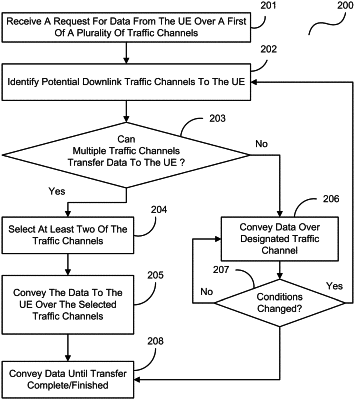| CPC H04W 24/08 (2013.01) [H04W 28/085 (2013.01); H04W 76/15 (2018.02)] | 20 Claims |

|
1. A traffic processing apparatus for a multichannel communication system including first, second, and third traffic channels for at least two communication networks of the communication system, the traffic processing apparatus in operable communication with a user equipment device (UE) configured to communicate over the first traffic channel according to a first communication protocol and over the second traffic channel according to a second communication protocol different from the first communication protocol, the traffic processing apparatus comprising:
a processor; and
a memory device configured to store computer-executable instructions therein, which, when executed by the processor, cause the processor to:
(a) receive a request for data from the UE;
(b) evaluate the first and second traffic channels based on the requested data;
(c) identify first and second data components of the requested data, and separate the first data component from the second data component;
(d) select (i) the first traffic channel for the first component, and (ii) the second traffic channel for the second portion of the requested data;
(e) duplicate the second data component to generate a duplicated second data portion separate from the first and second data components; and
(f) convey (i) the first data component to the UE over the first traffic channel according to the first communication protocol, (ii) the second data component to the UE over the second traffic channel according to the second communication protocol, and (iii) the duplicated second data portion over the third traffic channel according to the first communication protocol.
|